Abstract
A three compartment physiologically based toxicokinetic model was fitted to human data on benzene disposition. Two separate groups of model parameter derivations were obtained, depending on which data sets were being fitted. The model was then used to simulate five environmental or occupational exposures. Predicted values of the total bone marrow exposure to benzene and cumulative quantity of metabolites produced by the bone marrow were generated for each scenario. The relation between cumulative quantity of metabolites produced by the bone marrow and continuous benzene exposure was also investigated in detail for simulated inhalation exposure concentrations ranging from 0.0039 ppm to 150 ppm. At the level of environmental exposures, no dose rate effect was found for either model. The occupational exposures led to only slight dose rate effects. A 32 ppm exposure for 15 minutes predicted consistently higher values than a 1 ppm exposure for eight hours for the total exposure of bone marrow to benzene and the cumulative quantity of metabolites produced by the bone marrow. The general relation between the cumulative quantity of metabolites produced by the bone marrow and the inhalation concentration of benzene is not linear. An inflection point exists in some cases leading to a slightly S shaped curve. At environmental levels (0.0039-10 ppm) the curve bends upward, and it saturates at high experimental exposures (greater than 100 ppm).
Full text
PDF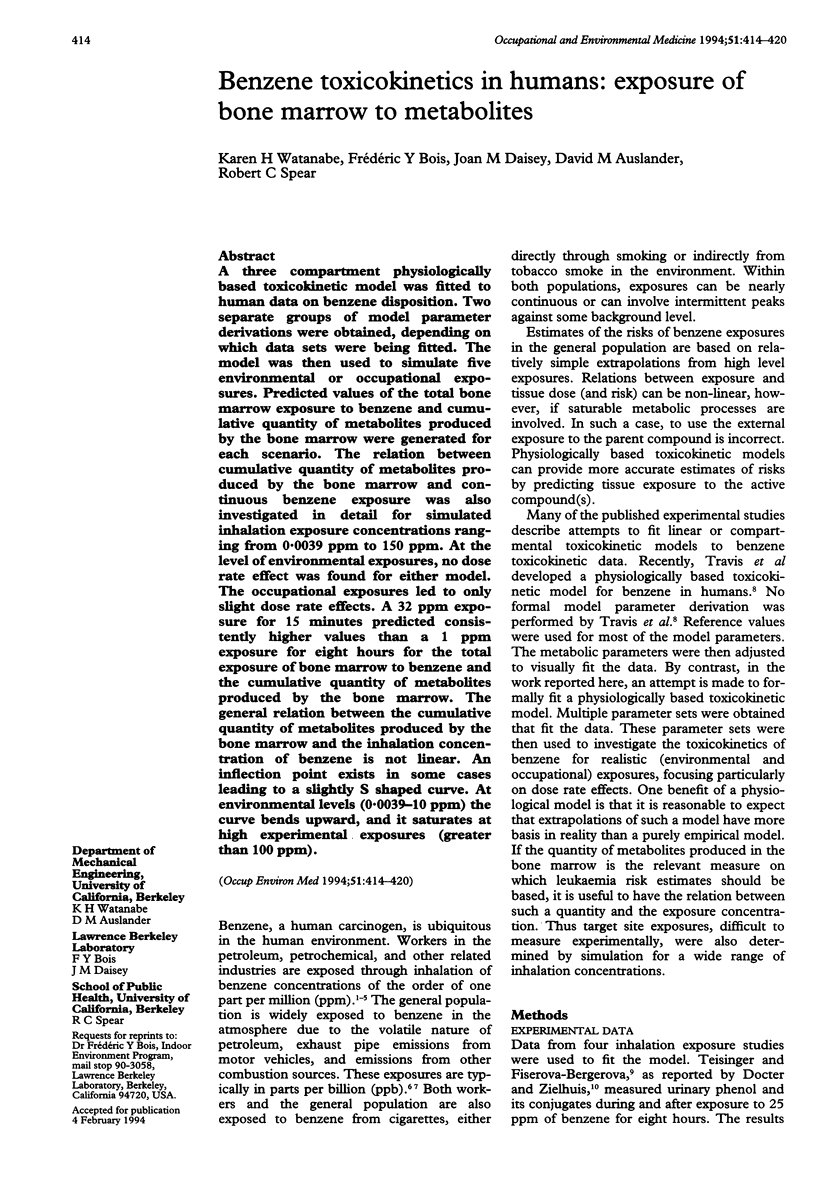
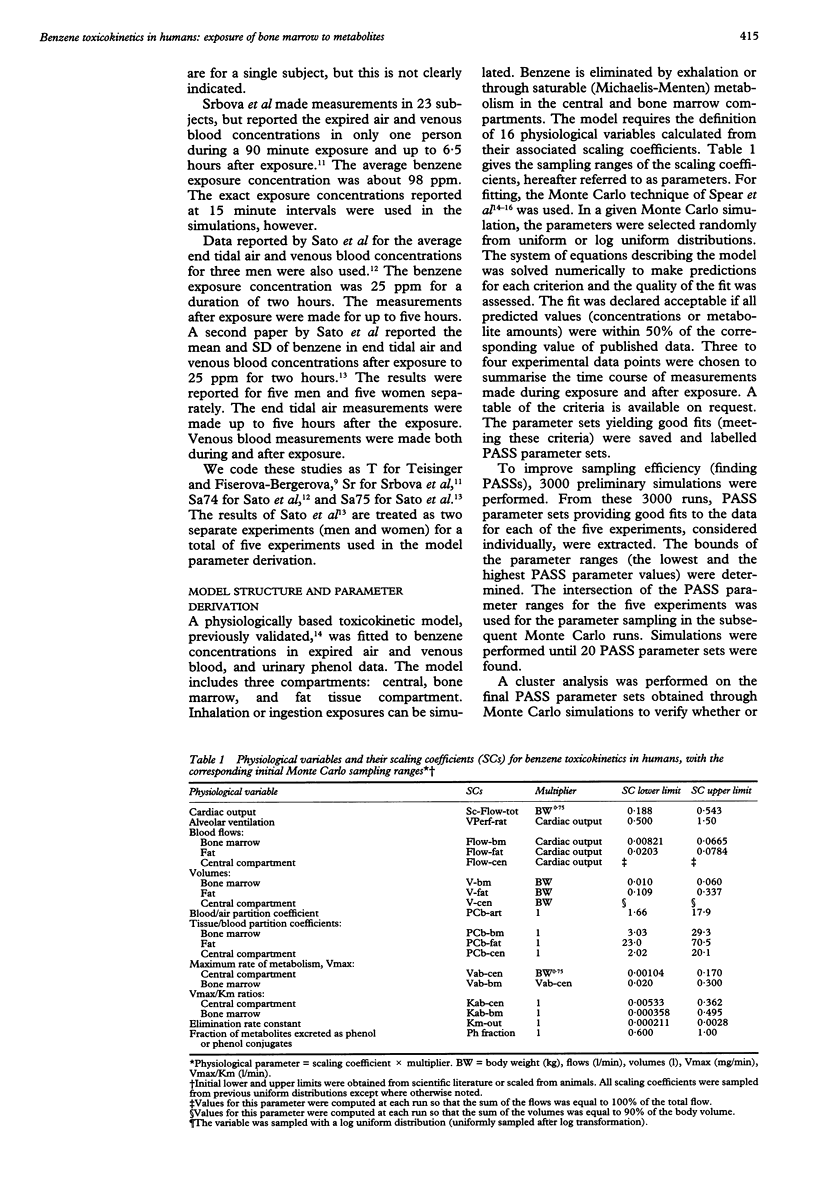
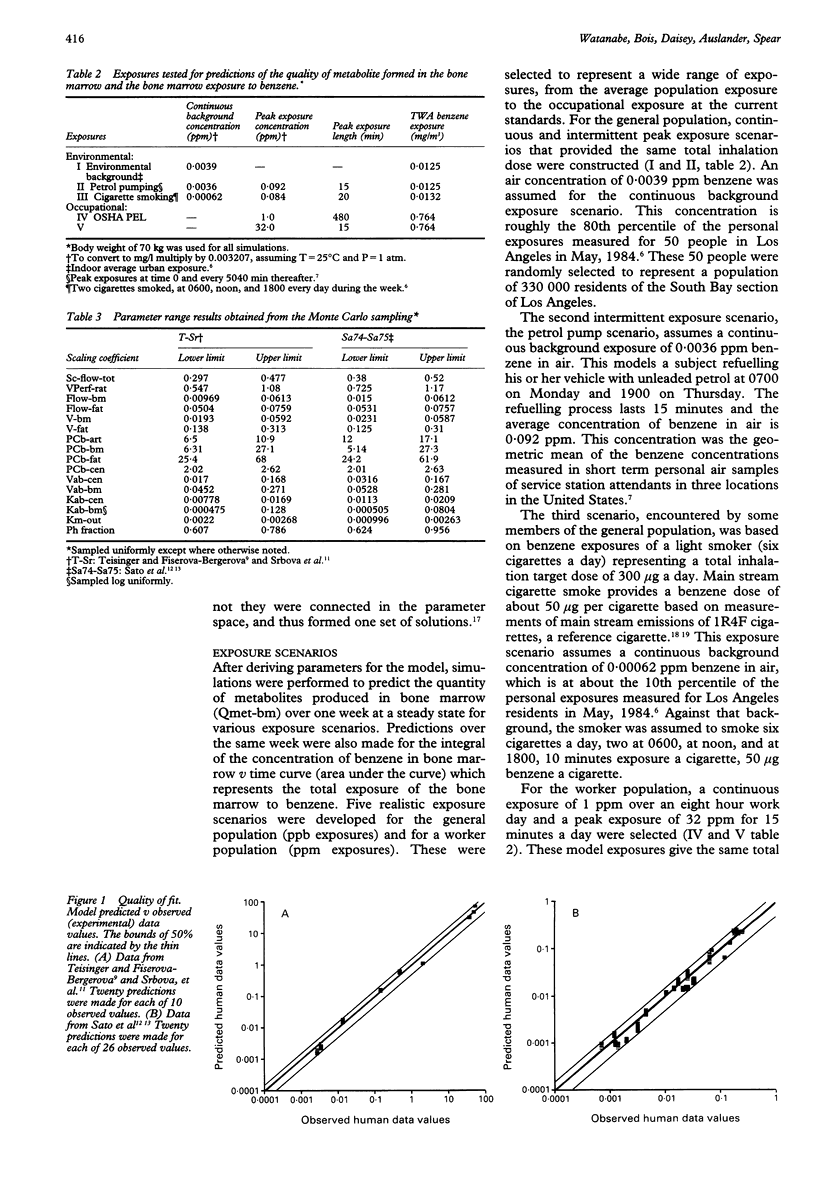
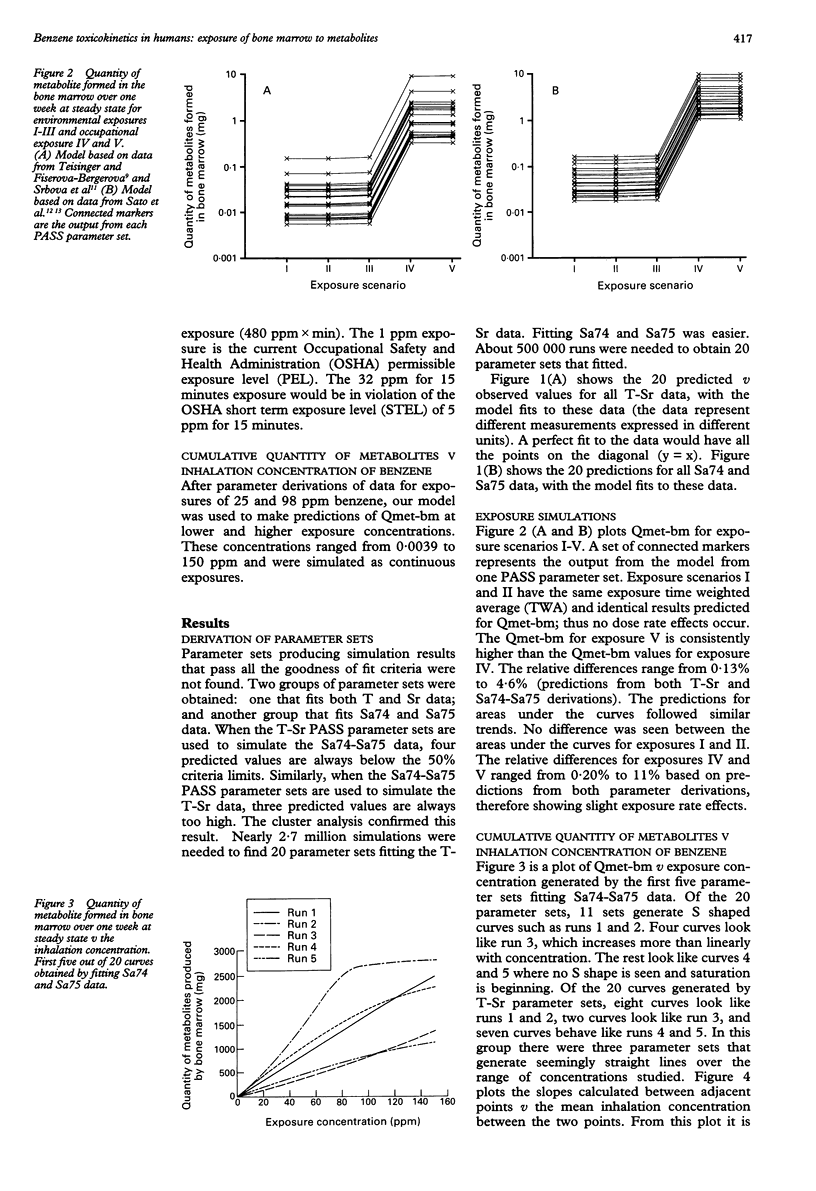
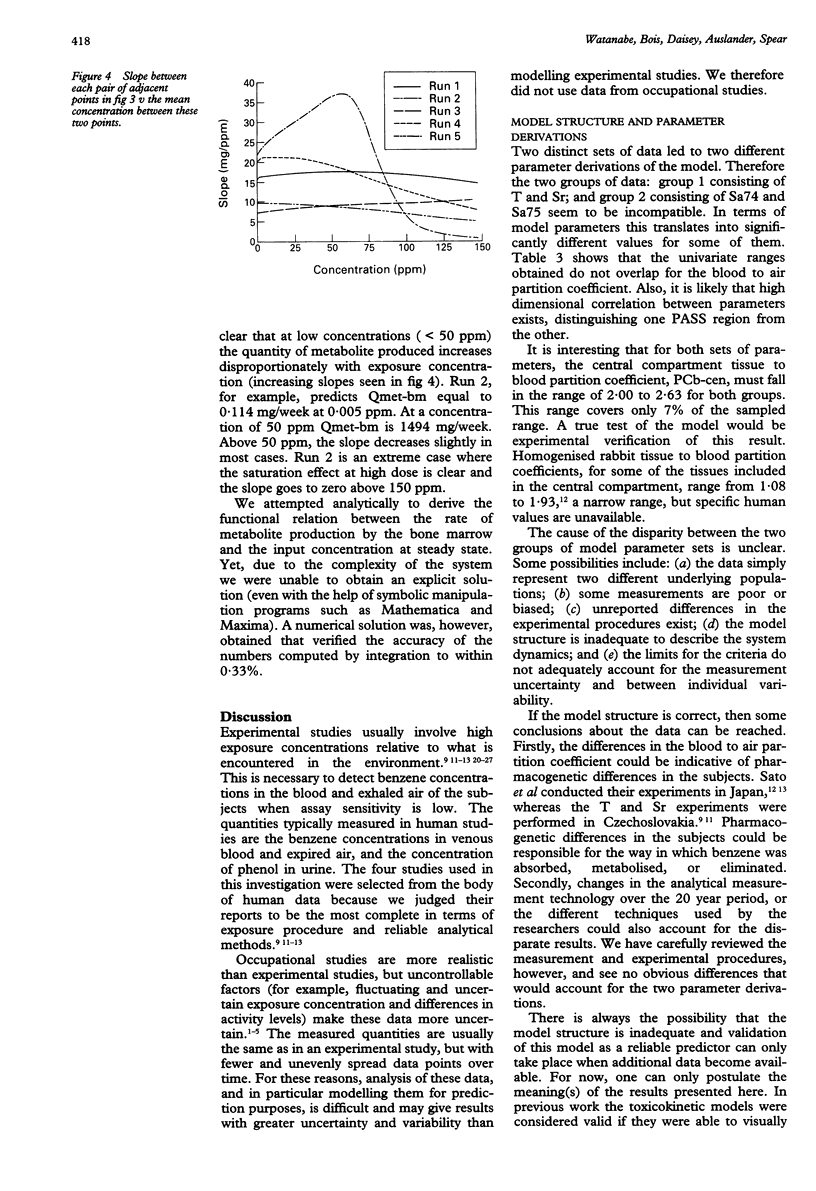
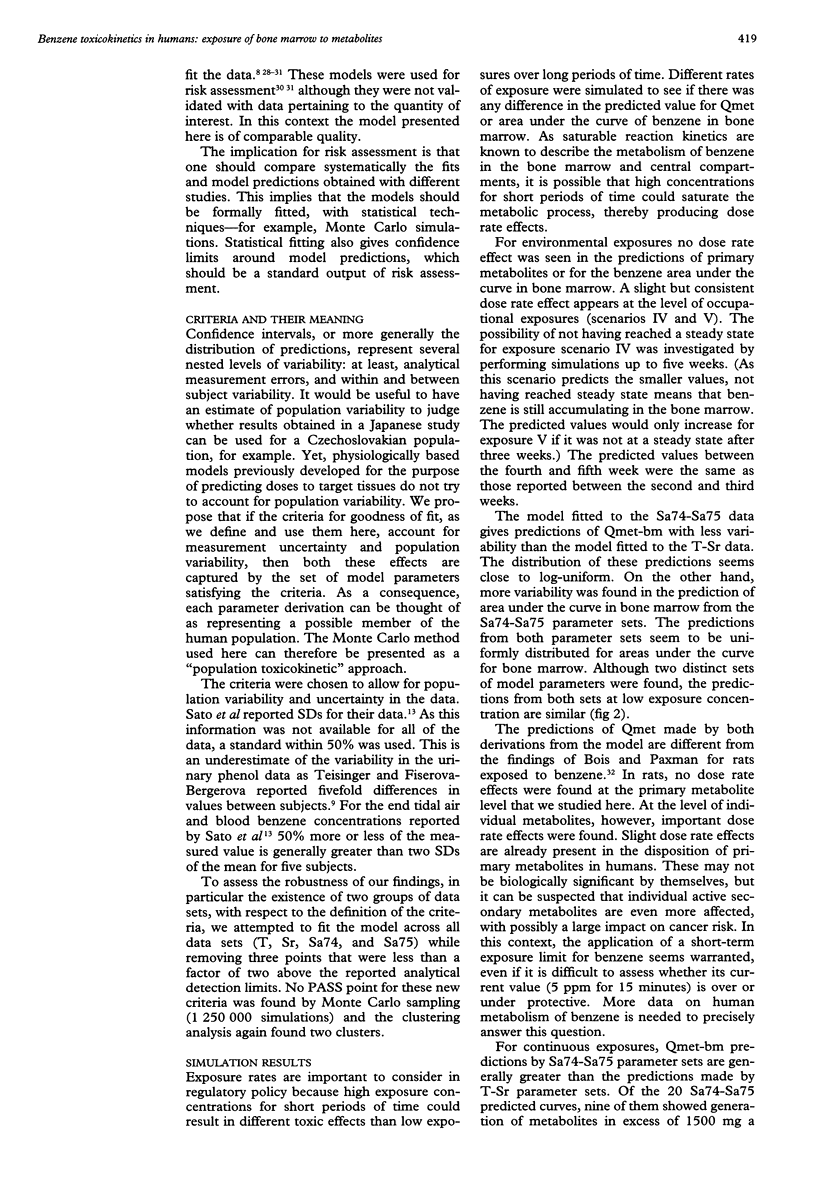
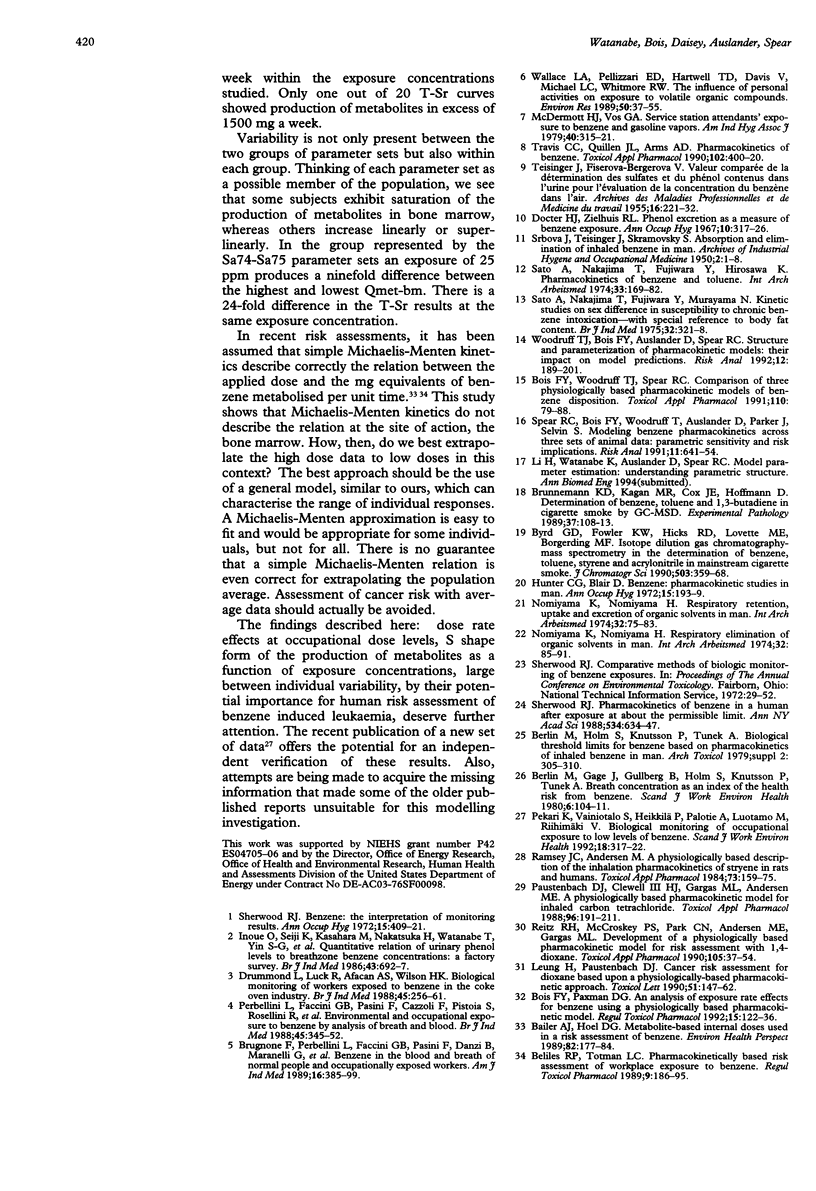
Selected References
These references are in PubMed. This may not be the complete list of references from this article.
- Bailer A. J., Hoel D. G. Metabolite-based internal doses used in a risk assessment of benzene. Environ Health Perspect. 1989 Jul;82:177–184. doi: 10.1289/ehp.8982177. [DOI] [PMC free article] [PubMed] [Google Scholar]
- Beliles R. P., Totman L. C. Pharmacokinetically based risk assessment of workplace exposure to benzene. Regul Toxicol Pharmacol. 1989 Apr;9(2):186–195. doi: 10.1016/0273-2300(89)90035-4. [DOI] [PubMed] [Google Scholar]
- Berlin M., Gage J. C., Gullberg B., Holm S., Knutsson P., Eng C., Tunek A. Breath concentration as an index of the health risk from benzene. Studies on the accumulation and clearance of inhaled benzene. Scand J Work Environ Health. 1980 Jun;6(2):104–111. doi: 10.5271/sjweh.2625. [DOI] [PubMed] [Google Scholar]
- Berlin M., Holm S., Knutsson P., Tunek A. Biological threshold limits for benzene based on pharmacokinetics of inhaled benzene in man. Arch Toxicol Suppl. 1979;(2):305–310. doi: 10.1007/978-3-642-67265-1_27. [DOI] [PubMed] [Google Scholar]
- Bois F. Y., Paxman D. G. An analysis of exposure rate effects for benzene using a physiologically based pharmacokinetic model. Regul Toxicol Pharmacol. 1992 Apr;15(2 Pt 1):122–136. doi: 10.1016/0273-2300(92)90044-a. [DOI] [PubMed] [Google Scholar]
- Bois F. Y., Woodruff T. J., Spear R. C. Comparison of three physiologically based pharmacokinetic models of benzene disposition. Toxicol Appl Pharmacol. 1991 Aug;110(1):79–88. doi: 10.1016/0041-008x(91)90291-l. [DOI] [PubMed] [Google Scholar]
- Brugnone F., Perbellini L., Faccini G. B., Pasini F., Danzi B., Maranelli G., Romeo L., Gobbi M., Zedde A. Benzene in the blood and breath of normal people and occupationally exposed workers. Am J Ind Med. 1989;16(4):385–399. doi: 10.1002/ajim.4700160406. [DOI] [PubMed] [Google Scholar]
- Brunnemann K. D., Kagan M. R., Cox J. E., Hoffmann D. Determination of benzene, toluene and 1,3-butadiene in cigarette smoke by GC-MDS. Exp Pathol. 1989;37(1-4):108–113. doi: 10.1016/s0232-1513(89)80026-x. [DOI] [PubMed] [Google Scholar]
- Byrd G. D., Fowler K. W., Hicks R. D., Lovette M. E., Borgerding M. F. Isotope dilution gas chromatography-mass spectrometry in the determination of benzene, toluene, styrene and acrylonitrile in mainstream cigarette smoke. J Chromatogr. 1990 Mar 23;503(2):359–368. doi: 10.1016/s0021-9673(01)81515-6. [DOI] [PubMed] [Google Scholar]
- Docter H. J., Zielhuis R. L. Phenol excretion as a measure of benzene exposure. Ann Occup Hyg. 1967 Oct;10(4):317–326. doi: 10.1093/annhyg/10.4.317. [DOI] [PubMed] [Google Scholar]
- Drummond L., Luck R., Afacan A. S., Wilson H. K. Biological monitoring of workers exposed to benzene in the coke oven industry. Br J Ind Med. 1988 Apr;45(4):256–261. doi: 10.1136/oem.45.4.256. [DOI] [PMC free article] [PubMed] [Google Scholar]
- Hunter C. G., Blair D. Benzene: pharmacokinetic studies in man. Ann Occup Hyg. 1972 Nov;15(2):193–201. doi: 10.1093/annhyg/15.2-4.193. [DOI] [PubMed] [Google Scholar]
- Inoue O., Seiji K., Kasahara M., Nakatsuka H., Watanabe T., Yin S. G., Li G. L., Jin C., Cai S. X., Wang X. Z. Quantitative relation of urinary phenol levels to breathzone benzene concentrations: a factory survey. Br J Ind Med. 1986 Oct;43(10):692–697. doi: 10.1136/oem.43.10.692. [DOI] [PMC free article] [PubMed] [Google Scholar]
- Leung H. W., Paustenbach D. J. Cancer risk assessment for dioxane based upon a physiologically-based pharmacokinetic approach. Toxicol Lett. 1990 Apr;51(2):147–162. doi: 10.1016/0378-4274(90)90207-3. [DOI] [PubMed] [Google Scholar]
- McDermott H. J., Vos G. A. Service station attendants' exposure to benzene and gasoline vapors. Am Ind Hyg Assoc J. 1979 Apr;40(4):315–321. doi: 10.1080/15298667991429642. [DOI] [PubMed] [Google Scholar]
- Nomiyama K., Nomiyama H. Respiratory elimination of organic solvents in man. Benzene, toluene, n-hexane, trichloroethylene, acetone, ethyl acetate and ethyl alcohol. Int Arch Arbeitsmed. 1974;32(1):85–91. doi: 10.1007/BF00539098. [DOI] [PubMed] [Google Scholar]
- Nomiyama K., Nomiyama H. Respiratory retention, uptake and excretion of organic solvents in man. Int Arch Arbeitsmed. 1974;32(1):75–83. doi: 10.1007/BF00539097. [DOI] [PubMed] [Google Scholar]
- Paustenbach D. J., Clewell H. J., 3rd, Gargas M. L., Andersen M. E. A physiologically based pharmacokinetic model for inhaled carbon tetrachloride. Toxicol Appl Pharmacol. 1988 Nov;96(2):191–211. doi: 10.1016/0041-008x(88)90080-4. [DOI] [PubMed] [Google Scholar]
- Pekari K., Vainiotalo S., Heikkilä P., Palotie A., Luotamo M., Riihimäki V. Biological monitoring of occupational exposure to low levels of benzene. Scand J Work Environ Health. 1992 Oct;18(5):317–322. doi: 10.5271/sjweh.1570. [DOI] [PubMed] [Google Scholar]
- Perbellini L., Faccini G. B., Pasini F., Cazzoli F., Pistoia S., Rosellini R., Valsecchi M., Brugnone F. Environmental and occupational exposure to benzene by analysis of breath and blood. Br J Ind Med. 1988 May;45(5):345–352. doi: 10.1136/oem.45.5.345. [DOI] [PMC free article] [PubMed] [Google Scholar]
- Ramsey J. C., Andersen M. E. A physiologically based description of the inhalation pharmacokinetics of styrene in rats and humans. Toxicol Appl Pharmacol. 1984 Mar 30;73(1):159–175. doi: 10.1016/0041-008x(84)90064-4. [DOI] [PubMed] [Google Scholar]
- Reitz R. H., McCroskey P. S., Park C. N., Andersen M. E., Gargas M. L. Development of a physiologically based pharmacokinetic model for risk assessment with 1,4-dioxane. Toxicol Appl Pharmacol. 1990 Aug;105(1):37–54. doi: 10.1016/0041-008x(90)90357-z. [DOI] [PubMed] [Google Scholar]
- SRBOVA J., TEISINGER J., SKRAMOVSKY S. Absorption and elimination of inhaled benzene in man. Arch Ind Hyg Occup Med. 1950 Jul;2(1):1–8. [PubMed] [Google Scholar]
- Sato A., Nakajima T., Fujiwara Y., Hirosawa K. Pharmacokinetics of benzene and toluene. Int Arch Arbeitsmed. 1974;33(3):169–182. doi: 10.1007/BF00538916. [DOI] [PubMed] [Google Scholar]
- Sato A., Nakajima T., Fujiwara Y., Murayama N. Kinetic studies on sex difference in susceptibility to chronic benzene intoxication--with special reference to body fat content. Br J Ind Med. 1975 Nov;32(4):321–328. doi: 10.1136/oem.32.4.321. [DOI] [PMC free article] [PubMed] [Google Scholar]
- Sherwood R. J. Benzene: the interpretation of monitoring results. Ann Occup Hyg. 1972 Nov;15(2):409–423. doi: 10.1093/annhyg/15.2-4.409. [DOI] [PubMed] [Google Scholar]
- Spear R. C., Bois F. Y., Woodruff T., Auslander D., Parker J., Selvin S. Modeling benzene pharmacokinetics across three sets of animal data: parametric sensitivity and risk implications. Risk Anal. 1991 Dec;11(4):641–654. doi: 10.1111/j.1539-6924.1991.tb00653.x. [DOI] [PubMed] [Google Scholar]
- TEISINGER J., FISEROVA-BERGEROVA V., MENSIKOVA J. Valeur comparée de la détermination des sulfates et du phénol contenus dans l'urine pour l'évaluation de la concentration du benzène dans l'air. Arch Mal Prof. 1955;16(3):221–232. [PubMed] [Google Scholar]
- Travis C. C., Quillen J. L., Arms A. D. Pharmacokinetics of benzene. Toxicol Appl Pharmacol. 1990 Mar 1;102(3):400–420. doi: 10.1016/0041-008x(90)90037-u. [DOI] [PubMed] [Google Scholar]
- Wallace L. A., Pellizzari E. D., Hartwell T. D., Davis V., Michael L. C., Whitmore R. W. The influence of personal activities on exposure to volatile organic compounds. Environ Res. 1989 Oct;50(1):37–55. doi: 10.1016/s0013-9351(89)80047-7. [DOI] [PubMed] [Google Scholar]
- Woodruff T. J., Bois F. Y., Auslander D., Spear R. C. Structure and parameterization of pharmacokinetic models: their impact on model predictions. Risk Anal. 1992 Jun;12(2):189–201. doi: 10.1111/j.1539-6924.1992.tb00667.x. [DOI] [PubMed] [Google Scholar]


